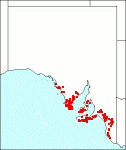Family: Rhamnaceae
Pomaderris obcordata
Citation:
Fenzl in Endl., Enum. Pl. Hügel 22 (1837).
Synonymy: Pomaderris biauritum, Trymalium biauritum Common name: Wedge-leaved pomaderris.
Description:
Usually a low shrub 30-60 cm high but occasionally to 3 m; leaves long-cuneate, distally 2-lobed or obcordate or less often more or less truncate-dentate, often mucronate, otherwise entire or denticulate, flat or the margins narrowly recurved, the blade 6-18 x 2-12 mm, stellate-tomentose below, less dense to glabrous above, tapered to the often distinct c. 1-2 mm long petioles.
Flowers in small terminal umbel-like clusters at first enclosed by brown caducous bracts; pedicels usually 2-3 mm in flower but lengthening to 8 mm in fruit; peduncles, pedicels and the outside of the calyx grey-stellate-tomentose; ovary c. 1 mm long; sepals c. 2 mm long; petals 0; style divided to about the middle, with stigmas capitate; ovary extending well above the insertion of the calyx, densely long-hairy.
Fruitlets opening along the inner suture, without a deciduous valve.

| Pomaderris obcordata inflorescence and flower with a second leaf shape
|
Image source: fig 428d in Jessop J.P. & Toelken H.R. (Ed.) 1986. Flora of South Australia (4th edn).
|
|
|
Distribution:
|
Usually recorded in mallee scrub on limestone but also in heath and on sand.
S.Aust.: EP, MU, YP, SL, KI, SE. W.Aust.; Vic.
|
Conservation status:
native
Flowering time: usually May — Sept.
|

SA Distribution Map based
on current data relating to
specimens held in the
State Herbarium of South Australia
|
Biology:
No text
Taxonomic notes:
The less deeply lobed leaves such as are particularly common in EP often approach those of Trymalium wayi in general form. This species, with its lobed leaves and long pedicels is otherwise rather distinct. Vegetatively this species resembles Spyridium halmaturinum and S. bifidum.
Author:
Not yet available
|

